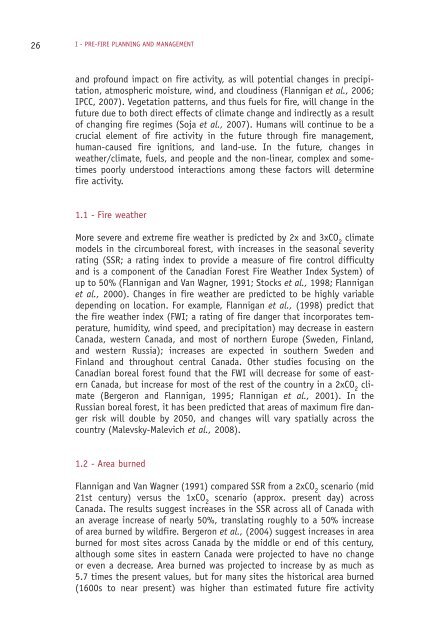7th Workshop on Forest Fire Management - EARSeL, European ...
7th Workshop on Forest Fire Management - EARSeL, European ...
7th Workshop on Forest Fire Management - EARSeL, European ...
You also want an ePaper? Increase the reach of your titles
YUMPU automatically turns print PDFs into web optimized ePapers that Google loves.
26<br />
I - PRE-FIRE PLANNING AND MANAGEMENT<br />
and profound impact <strong>on</strong> fire activity, as will potential changes in precipitati<strong>on</strong>,<br />
atmospheric moisture, wind, and cloudiness (Flannigan et al., 2006;<br />
IPCC, 2007). Vegetati<strong>on</strong> patterns, and thus fuels for fire, will change in the<br />
future due to both direct effects of climate change and indirectly as a result<br />
of changing fire regimes (Soja et al., 2007). Humans will c<strong>on</strong>tinue to be a<br />
crucial element of fire activity in the future through fire management,<br />
human-caused fire igniti<strong>on</strong>s, and land-use. In the future, changes in<br />
weather/climate, fuels, and people and the n<strong>on</strong>-linear, complex and sometimes<br />
poorly understood interacti<strong>on</strong>s am<strong>on</strong>g these factors will determine<br />
fire activity.<br />
1.1 - <strong>Fire</strong> weather<br />
More severe and extreme fire weather is predicted by 2x and 3xCO 2 climate<br />
models in the circumboreal forest, with increases in the seas<strong>on</strong>al severity<br />
rating (SSR; a rating index to provide a measure of fire c<strong>on</strong>trol difficulty<br />
and is a comp<strong>on</strong>ent of the Canadian <strong>Forest</strong> <strong>Fire</strong> Weather Index System) of<br />
up to 50% (Flannigan and Van Wagner, 1991; Stocks et al., 1998; Flannigan<br />
et al., 2000). Changes in fire weather are predicted to be highly variable<br />
depending <strong>on</strong> locati<strong>on</strong>. For example, Flannigan et al., (1998) predict that<br />
the fire weather index (FWI; a rating of fire danger that incorporates temperature,<br />
humidity, wind speed, and precipitati<strong>on</strong>) may decrease in eastern<br />
Canada, western Canada, and most of northern Europe (Sweden, Finland,<br />
and western Russia); increases are expected in southern Sweden and<br />
Finland and throughout central Canada. Other studies focusing <strong>on</strong> the<br />
Canadian boreal forest found that the FWI will decrease for some of eastern<br />
Canada, but increase for most of the rest of the country in a 2xCO 2 climate<br />
(Berger<strong>on</strong> and Flannigan, 1995; Flannigan et al., 2001). In the<br />
Russian boreal forest, it has been predicted that areas of maximum fire danger<br />
risk will double by 2050, and changes will vary spatially across the<br />
country (Malevsky-Malevich et al., 2008).<br />
1.2 - Area burned<br />
Flannigan and Van Wagner (1991) compared SSR from a 2xCO 2 scenario (mid<br />
21st century) versus the 1xCO 2 scenario (approx. present day) across<br />
Canada. The results suggest increases in the SSR across all of Canada with<br />
an average increase of nearly 50%, translating roughly to a 50% increase<br />
of area burned by wildfire. Berger<strong>on</strong> et al., (2004) suggest increases in area<br />
burned for most sites across Canada by the middle or end of this century,<br />
although some sites in eastern Canada were projected to have no change<br />
or even a decrease. Area burned was projected to increase by as much as<br />
5.7 times the present values, but for many sites the historical area burned<br />
(1600s to near present) was higher than estimated future fire activity
















